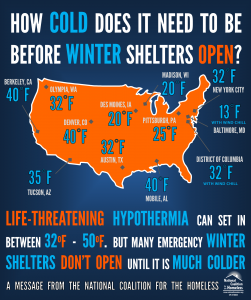 Resources
Resources
Winter Homeless Services: Bringing Our Neighbors in from the Cold (2010) | Seven hundred people experiencing or at risk of homelessness are killed from hypothermia annually in the United States. Forty-four percent of the nation’s homeless are unsheltered. From the urban streets of our populated cities to the remote back-country of rural America, hypothermia – or subnormal temperature in the body – remains a leading, critical and preventable cause of injury and death among those experiencing homelessness. The National Coalition for the Homeless has published Winter Homeless Services: Bringing Our Neighbors in from the Cold to raise awareness of the dangers and consequences of hypothermia on people experiencing homelessness.
Quick Tips for Shelter & Outreach Providers (2010) | Quick Tips for shelter providers/outreach staff for keeping people warm in cold weather and recognizing and dealing with hypothermia and frostbite. Health Care for the Homeless Network, Public Health – Seattle & King County
Exposure-Related Conditions: Symptoms & Prevention Strategies (2007) | Exposure-related conditions are a constant reality faced by homeless individuals who spend most days and many nights outside. Without shelter against the elements, they are dependent on mild temperatures and dry weather for a tolerable existence. And while some people who live on the streets may have tents or cardboard structures to provide a modicum of protection and privacy, they are still susceptible to hypo- or hyperthermia as well as associated maladies including frostbite, sunburn, and heat exhaustion. Those who are very young, old, malnourished or exhausted are at increased risk of serious health problems from exposure to temperature extremes. This issue discusses signs and symptoms of cold- and heat-related pathologies and how to prevent them.
A Case of Trench Foot in a Homeless Woman (2007) | This article describes a cold-related tissue injury that may be overlooked by healthcare practitioners who treat homeless clients: trench foot. Trench foot is a preventable condition which can be mitigated by early intervention but which, because it occurs at above-freezing temperatures, might go unrecognized and untreated. The sequelae of unrecognized and untreated trench foot can be dire.